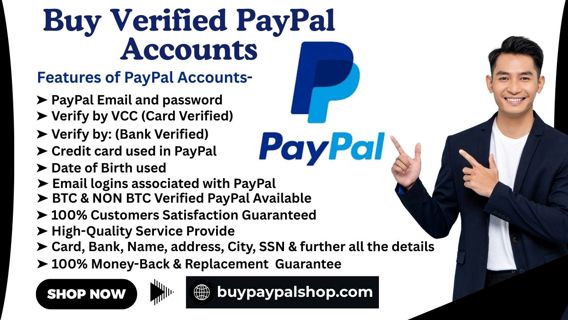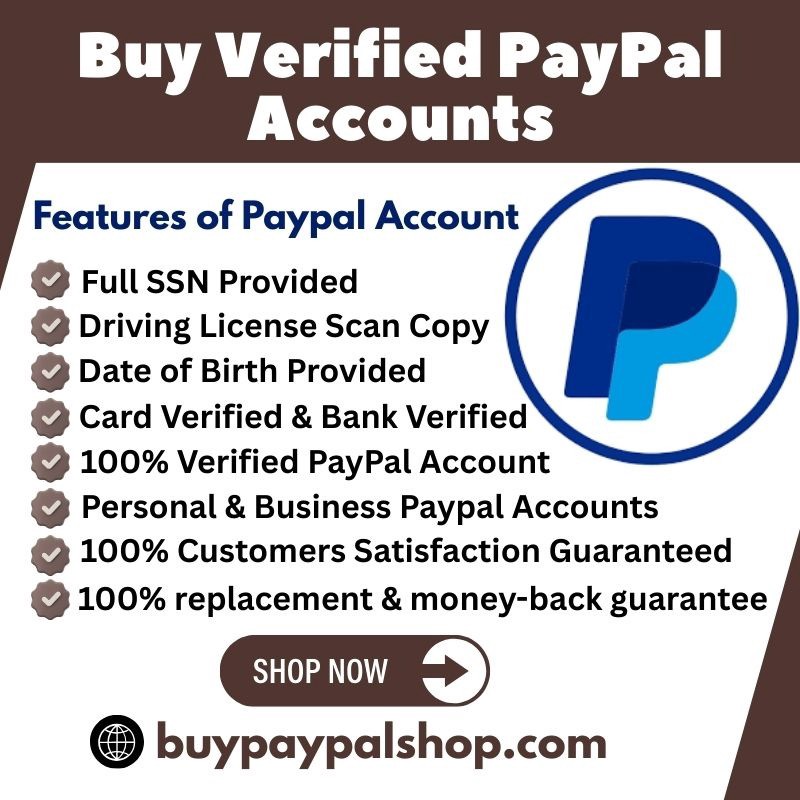
Introduction
In the digital era, where online payments are becoming the backbone of global commerce, PayPal stands as one of the most trusted platforms for sending and receiving money. Millions of users around the world rely on PayPal for everything from online shopping to freelance work and business transactions. However, one question often pops up among users — Is a verified PayPal account really safer? Before hitting that “verify” button, it’s important to understand exactly what it means, how it impacts your account, and whether it truly enhances your online security.
A verified PayPal account gives users more than just a shiny badge; it’s often viewed as a mark of authenticity and reliability. It tells PayPal — and everyone you interact with — that you are a real person or business with valid financial backing. But that doesn’t automatically mean you’re immune to fraud or scams. Verification increases trust, but safety is a shared responsibility between the platform and the user. Buy verified paypal accounts
24 Hours Reply/ Contact Us
✅ Telegram: @buypaypalshop
✅ Email: [email protected]
Understanding this distinction is key to making informed choices. In this article, we’ll break down everything you need to know about PayPal verification — from its process and benefits to potential risks and myths — so you can decide whether verifying your account is the right move for you.
What Is a Verified PayPal Account?
A verified PayPal account is one that has gone through PayPal’s identity confirmation process. When you first create an account, you’re considered “unverified,” meaning your access to certain features and transaction limits may be restricted. Verification typically involves linking your bank account or credit card and confirming your identity, ensuring that you are who you say you are.
PayPal uses this process to reduce fraud and ensure that all transactions are tied to legitimate financial sources. When you verify your account, you prove ownership of a valid bank account or card, which allows PayPal to confirm that your funds come from a legitimate source.
There are notable differences between verified and unverified accounts:
Transaction Limits: Unverified accounts often face sending, receiving, or withdrawal limits.
Reputation: Verified accounts carry more credibility when dealing with online buyers or clients.
Access to Features: Some PayPal services, such as certain business tools or large transactions, require verification.
Essentially, verification opens up the full potential of your PayPal account while signaling to others that you’re trustworthy and transparent in your financial dealings.
Why PayPal Verification Matters
Verification does more than just remove restrictions — it’s a trust-building measure. When you’re verified, it reassures others that you’re a genuine user backed by a legitimate financial institution. This is especially crucial for freelancers, eCommerce sellers, and small businesses who rely on PayPal for daily transactions.
Here are the top reasons why verification matters:
Trust and Credibility: Verified users are seen as more reliable. If you’re selling a product or service, buyers are more likely to feel comfortable paying you.
Higher Limits: PayPal often caps how much money you can send, receive, or withdraw until verification is completed. Verifying removes those barriers.
Access to Business Tools: For business accounts, verification enables features like invoice management, PayPal Credit, and API integrations.
Account Recovery: In case of disputes or fraud, verified accounts are easier to recover since PayPal has your verified details.
Think of verification as adding an extra layer of legitimacy to your online presence — like showing your ID before entering a secure building. It may not stop every threat, but it ensures that your account is taken seriously in the digital marketplace. Buy verified paypal accounts
The Security Advantages of a Verified PayPal Account
While PayPal already offers robust protection, verification enhances it further. One of the biggest benefits is fraud prevention. By linking your PayPal to verified financial accounts, you make it harder for scammers to impersonate you. Verification helps PayPal detect suspicious activity faster since there’s a clear link between your identity and your account.
Other security advantages include:
Advanced Encryption: Verified accounts benefit from stronger encryption and continuous security monitoring.
Reduced Risk of Payment Holds: PayPal can more easily verify transaction legitimacy, reducing the chances of frozen funds.
Increased Buyer/Seller Protection Eligibility: Verified accounts are often required to access full protection coverage under PayPal’s policies.
Improved Dispute Resolution: Since PayPal can confirm your identity, resolving disputes becomes quicker and smoother.
However, verification isn’t a magic shield. It won’t stop phishing scams or social engineering attacks — those require user awareness and vigilance. Still, verification gives PayPal the tools it needs to keep your account more secure and accountable.
Potential Risks and Misunderstandings About Verification
Many users assume that verifying their PayPal account makes them completely safe from hackers or fraudsters. Unfortunately, that’s not the case. While verification boosts trust and adds legitimacy, it doesn’t make your account bulletproof.
Here are some common misunderstandings:
“Verified means 100% safe.” Wrong — verification only confirms your identity, not your invulnerability to scams.
“Verification removes all limits instantly.” Some limits remain in place for security reasons.
“Scammers can’t target verified accounts.” In fact, scammers often target verified users because they handle more transactions.
Potential risks include phishing attacks where scammers mimic PayPal’s emails, asking for your login credentials or bank details. Always verify email senders and log in only through PayPal’s official site or app.
24 Hours Reply/ Contact Us
✅ Telegram: @buypaypalshop
✅ Email: [email protected]

Moreover, by verifying your account, you’re linking real financial information — so you must keep your device secure and avoid public Wi-Fi when accessing PayPal. Verification increases safety, but ultimate security depends on your personal habits and caution.
How to Verify Your PayPal Account (Step-by-Step Guide)
Verifying your PayPal account is a simple process, but it requires attention to detail. Whether you’re using PayPal for personal transactions or business purposes, following the right steps ensures a smooth and secure verification experience.
Here’s a step-by-step guide to help you verify your account successfully:
Log In to Your PayPal Account
Start by logging in to your account on the official PayPal website or app. Avoid clicking links from emails — scammers often send fake PayPal messages designed to steal login credentials.Link Your Bank Account or Credit Card
PayPal will prompt you to link a bank account or debit/credit card. You can link both for added security and flexibility. Once linked, PayPal will make two small deposits (usually less than $1 each) to your bank account.Confirm Deposits
Check your bank statement or online banking app for the two small PayPal deposits. Enter these exact amounts on PayPal’s verification page to confirm your ownership.Verify Identity (if required)
In some cases, PayPal might ask for identity verification. You may need to upload a government-issued ID or utility bill. This extra step strengthens your account security and ensures compliance with financial regulations.Complete the Process
Once your information is verified, PayPal will mark your account as “Verified.” You’ll notice increased transaction limits and access to more features.
Pro tip: Make sure your name and address match exactly across your PayPal and bank account. Mismatched information can delay or even block the verification process.
Differences Between Personal and Business Verification
PayPal offers two main account types: Personal and Business. While both can be verified, the process and benefits differ. Understanding these differences will help you choose the right setup for your needs.
Personal Account Verification
For individuals who use PayPal for online shopping, freelance payments, or peer-to-peer transactions, verification mainly involves confirming a bank account or card. The goal is to prove that you’re a legitimate individual user.
Benefits include:
Increased transfer and withdrawal limits
Access to PayPal Credit (where available)
Enhanced buyer and seller protection
Quicker resolution in disputes
Business Account Verification
For businesses or freelancers receiving regular payments, PayPal’s Business Verification is more in-depth. It includes not only confirming a bank account but also verifying your business name, tax ID, and legal documentation.
Benefits include:
Customizable invoices and payment buttons
Ability to receive payments under your brand name
Integration with eCommerce platforms (like Shopify or WooCommerce)
Priority customer support for verified business accounts
PayPal performs additional checks for business accounts to prevent fraud and money laundering. While the process may take longer, it boosts your company’s credibility and customer trust significantly.
Visit My Website : buy verified paypal accounts
24 Hours Reply/ Contact Us
✅ Telegram: @buypaypalshop
✅ Email: [email protected]
Is Verification Necessary for Safety or Just Convenience?
It’s easy to assume that verifying your PayPal account is just a convenience — something optional for frequent users. However, the truth is more nuanced. Verification isn’t only about convenience; it plays a major role in how PayPal manages trust, limits, and risk.
Let’s break it down.
Without Verification
If you don’t verify your PayPal account, you can still send and receive money, but you’ll face limitations:
Lower transaction caps (usually a few hundred dollars per month)
Possible payment holds or delays
Reduced access to PayPal’s Buyer/Seller Protection
Limited withdrawal options
In essence, an unverified account functions like a “trial mode” version of PayPal. You can use it, but you’re restricted from fully benefiting from the platform’s security and trust features.
With Verification
Once you verify your account:
Transaction limits are removed or significantly increased.
PayPal recognizes your account as “high trust.”
Disputes and chargebacks are resolved faster.
You gain full access to global transactions and business tools.
However, it’s important to note that verification doesn’t automatically make your funds immune to fraud. Think of it like locking your car door — it keeps most intruders out, but it doesn’t guarantee absolute safety. Combining verification with smart online habits is the best way to stay secure.
PayPal Buyer and Seller Protections Explained
One of PayPal’s strongest selling points is its Buyer and Seller Protection programs. These policies are designed to protect both sides of a transaction, especially when dealing with online purchases and sales.
Buyer Protection
If you purchase an item and it doesn’t arrive, or it’s significantly different from what was described, PayPal allows you to open a dispute within 180 days. If PayPal finds your claim valid, you’ll receive a full refund, including shipping costs.
However, Buyer Protection only applies when you:
Pay for goods or services using the correct payment option.
Complete the transaction through PayPal (not off-platform).
Don’t violate PayPal’s terms (e.g., buying prohibited items).
Verified accounts often enjoy smoother dispute processes since their payment methods and identity have been confirmed.
Seller Protection
For sellers, verification adds a layer of legitimacy that helps during disputes. PayPal’s Seller Protection shields you from chargebacks and unauthorized claims if you:
Ship to the buyer’s confirmed address
Provide valid tracking information
Keep proof of delivery
Verified sellers are less likely to face account holds or frozen funds because PayPal can verify their transaction authenticity faster.
Dispute Resolution
If a dispute arises, PayPal acts as an intermediary to ensure fairness. Being verified means you’ve already passed identity checks, giving your case stronger credibility during investigations.
2. Currency Conversion Safety
When you send money in a different currency, PayPal automatically converts it. Verified users get better conversion accuracy and lower dispute risks since PayPal recognizes them as trustworthy senders.
However, always review PayPal’s current currency conversion rates before sending large sums, as rates fluctuate daily. A verified status doesn’t guarantee lower fees but often helps avoid unnecessary transaction scrutiny.
3. Country-Specific Verification Requirements
Different countries have varying rules for PayPal verification. For instance:
U.S. users usually verify through bank accounts or credit cards.
European users may need to confirm their identity through national ID or proof of address.
Asian users might be asked for additional KYC (Know Your Customer) documentation.
By completing verification, you comply with your country’s financial security regulations, reducing the chance of frozen funds or compliance reviews.
Common Problems During Verification and How to Fix Them
While PayPal verification is straightforward, users sometimes encounter issues that delay or complicate the process. Here are the most common problems — and how to resolve them efficiently.
1. Mismatched Information
One of the most frequent problems is when your PayPal information doesn’t match your bank or card details. For example, if your name is listed differently (“Jon Smith” vs. “Jonathan Smith”), PayPal might reject verification.
Fix:
Ensure all personal details match exactly across your PayPal and bank records before attempting verification. Update your profile if necessary.
2. Micro-Deposit Not Showing
PayPal sends two small deposits to your bank account to confirm ownership. Sometimes, these don’t appear right away.
Fix:
Wait 2–3 business days. If the deposits still don’t show, check with your bank or remove and re-link your account. Always verify you entered the correct account details.
3. Identity Verification Delays
PayPal may request documents such as an ID card, passport, or utility bill. Delays happen if images are blurry or incomplete.
Fix:
Upload clear, high-resolution images with all corners visible. Make sure your documents are up-to-date and show matching information.
4. Verification Failed Without Explanation
Occasionally, PayPal may not provide a specific reason for rejection.
Fix:
Contact PayPal Support directly through the Help Center or chat option. Provide clear documentation, and they can manually review and resolve your case.
5. Temporary Account Limitations
After starting verification, your account might temporarily restrict certain activities for security checks.
Fix:
Be patient. This process ensures the account owner is legitimate. Once verification completes, limitations are usually lifted automatically.
While these issues can be frustrating, they’re designed to protect users and maintain PayPal’s integrity. Taking the time to resolve them ensures your account operates safely and seamlessly.
Should You Verify Your PayPal Account? (Final Verdict)
So, is verifying your PayPal account truly worth it? The short answer — absolutely, yes.
Verification not only removes annoying transaction limits but also enhances your account’s credibility and security. Whether you’re an individual sending money to family, a freelancer getting paid internationally, or a business running eCommerce operations, verification gives you peace of mind and smoother transactions.
Let’s recap the major advantages:
Full access to all PayPal features and services
Higher trust and credibility with customers or clients
Reduced risk of transaction holds and disputes
Easier recovery in case of fraud or account compromise
However, remember that verification alone doesn’t guarantee 100% safety. The best approach is combining PayPal’s built-in protections with good online habits — such as using strong passwords, enabling two-factor authentication, and being alert for scams.
In the long run, verification is more than just a checkbox — it’s your ticket to safer, faster, and more professional digital transactions.
Conclusion
A verified PayPal account is definitely safer — but it’s not invincible. Verification helps PayPal confirm who you are, giving you credibility, higher limits, and smoother transactions. It also strengthens your account against fraud by tying it to legitimate financial sources. However, the ultimate responsibility for your security lies in your hands.
Stay vigilant, use PayPal’s safety tools wisely, and treat verification as a foundation for security — not a finish line. With the right combination of PayPal verification and smart digital hygiene, you can confidently send and receive payments without fear of fraud or financial loss.
0 件のコメント
この投稿にコメントしよう!
この投稿にはまだコメントがありません。
ぜひあなたの声を聞かせてください。
